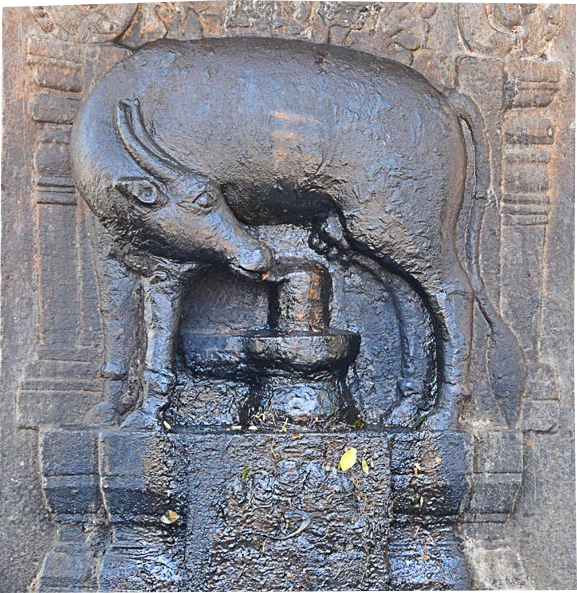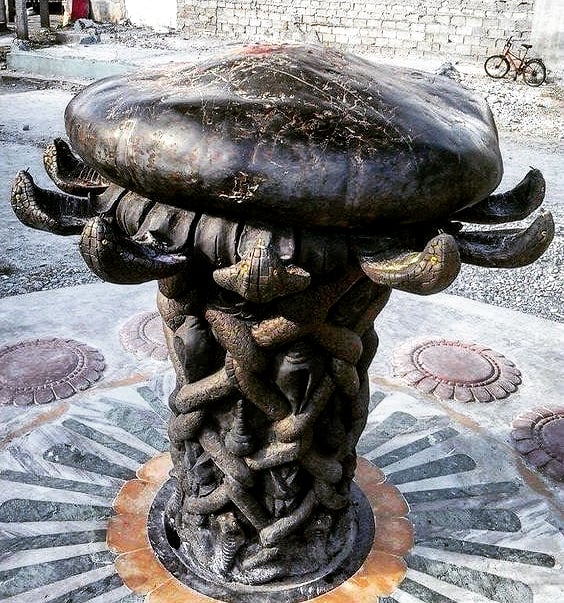Ancient Psychedelia: Alien Gods & Mushroom Goddesses
Online Book - Chapter 2, Page 39
Back to Online Book Mainpage / Next Page (Chapter 2, Page 40)
In India, the lingam has been a revered object for thousands of years. Are we really dealing with a symbol of fertility that relates more to the phallus or more to the mushroom? At the Shiva Lingam in the main temple at Ellora in India, both sides of the temple entrance have images of Shiva and they both have giant bold mushrooms above their heads, while the lingam shrine resides in the center (17d). In part of the Sthala Purana, Kamadhenu, the divine cow worshiped a Shiva lingam inside an anthill hoping to become the next Brahma and there is a monument to this in the Perur Shiva temple near Coimbatore city in Tamil Nadu (17b). Now, we have to wonder what a lingam was doing inside an anthill and why a cow would be licking it. Perhaps it is an occultation of the mushroom. (17d) Shiva Lingham in the main temple at Ellora, India (17d) Shiva Lingham in the main temple at Ellora, India (17b) Perur Shiva temple near Coimbatore city in Tamil Nadu In Nepal, we see something similar to the lingham in a statue with serpents all around the rim, and gills drawn all around on the group outlining the giant looking mushroom in the middle (27j).  (27j) Nepal Westropp and Wake, in the book Ancient Symbol Worship (1875), citing fellow researchers, write: “So far as I can discover, the serpent-symbol has not a direct phallic reference, nor, after all, is its attribute of wisdom the most essential. The idea most intimately associated with this animal was life, not present, but future, and ultimately, no doubt, eternal.” (45) |
According to Persian legend, in the Boun-Dehesh, Meschia and Meschaine, the first man and woman, were seduced by Ahriman, in the form of a serpent, when they first committed, “in thought, word, and action, the carnal sin, and thus tainted with original sin all their descendants.” (46) We will later see how Zeus mated with both Demeter and Persephone in the form of a serpent. The concept of the mushroom versus fertility in symbolism need not be black or white. When we see representations of the mushroom goddess, she can also be a fertility goddess, and vice versa. The debate over which was more important to represent visually in art seems to be weighed in the favor of both, in my personal opinion. If mushrooms gave early man, as Terrance McKenna suggests, insight to be able to advance in terms of language, and spoken word, hunting skills and cultural growth acceleration, then it would appear to be more significant than the concept of showing people that we mated and how important it was to us to have children. Men and women had been having children for hundreds of thousands of years, even millions, so why all of the sudden would they start drawing it? What did happen, was they started to evolve enough to draw cave art, and at this point, what were they drawing was mushroom men and women, possibly due to “visions.” Yes, they were drawing fertility sequences as well, but many of them were with mushroom headed people. So, was the act of fertility being conveyed here or the act of taking mushrooms and having visions, which led to writing on cave walls? I suggest the latter but let’s move on for now and leave this speculation for another time. Suffice it to say, that mushrooms played a role in relating the concepts of fertility, therefore they are forever interwoven in many conceivable ways. One way to look at it would be the “mushroom as the phallus of the goddess” in the sky with which she impregnates herself, as the earth. This would be the truly “hermaphroditic goddess.” One would think if “fertility” were the main concept being communicated, the phallus would play a more prominent role in the ancient sculptures, figurines and idols, but there are surprisingly few of them in early culture from all I have been able to gather and find. Ancient phallic sculptures are scarce, but mushroom figurines, on the other hand, are plentiful. Another important quality which the psychedelic mushroom has, is the ability to stimulate our minds which are our biggest sex organs. When the mind is working in all sorts of fantastic new ways, new ideas about sexuality emerge as well, and the mushroom can also act as an aphrodisiac in this way. (45) Ancient Symbol Worship, Westropp and Wake (1875), p.42; Lajard. Memoires de l’ Institut Royal de France, p. 182; Culte de Mithra, p. 35 (46) Ancient Symbol Worship, p. 47; Lajard, Le Cult de Mithra, p. 52-60 |
Go Back to Page 38